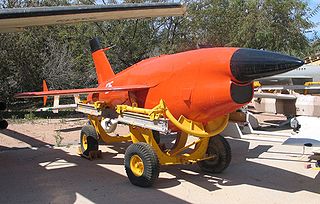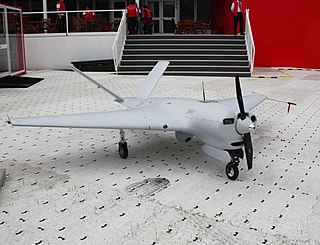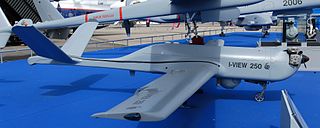The Alliant RQ-6 Outrider unmanned aerial vehicle (UAV) was designed to provide near-real-time reconnaissance, surveillance, and target acquisition information to United States Marine Corps air/ground task forces, United States Army brigades, and deployed United States Navy units that was small enough for an entire system to be contained on two Humvees and trailer and transported on a single C-130 Hercules cargo aircraft.

The General Atomics Gnat is an aerial reconnaissance UAV developed in the United States in the late 1980s and manufactured by General Atomics Aeronautical Systems (GA-ASI). As initially designed, it was a simplified version of the LSI Amber intended for foreign sales. The Gnat 750 made its first flight in 1989.

The Sikorsky Cypher and Cypher II are types of unmanned aerial vehicles developed by Sikorsky Aircraft. They are vertical takeoff and landing aircraft which use two opposing rotors enclosed in a circular shroud for propulsion.

The Bell Helicopter Eagle Eye, Model 918, was an American tiltrotor unmanned aerial vehicle that was offered as one of the competitors in the United States Navy's VT-UAV program.

A target drone is an unmanned aerial vehicle, generally remote controlled, usually used in the training of anti-aircraft crews.

The OQ-2 Radioplane was the first mass-produced UAV or drone in the United States, manufactured by the Radioplane Company. A follow-on version, the OQ-3, became the most widely used target drone in US service, with over 9,400 being built during World War II.

The BAE Systems Phoenix was an all-weather, day or night, real-time surveillance Unmanned Air Vehicle. It had a twin-boom UAV with a surveillance pod, from which the imagery was data linked to a ground control station (GCS) that also controlled the aircraft in flight. It was the third generation of UAV in British Army service with the Royal Artillery after SD/1 and Canadair Midge.

The DRDO Nishant is an unmanned aerial vehicle (UAV) developed by India's Aeronautical Development Establishment (ADE), a branch of Defence Research and Development Organisation (DRDO) for the Indian Armed Forces. The Nishant UAV is primarily tasked with intelligence gathering over enemy territory and also for reconnaissance, training, surveillance, target designation, artillery fire correction, damage assessment, ELINT and SIGINT. The UAV has an endurance of four hours and thirty minutes. Nishant has completed development phase and user trials.
The S-TEC Sentry is a reconnaissance unmanned aerial vehicle (UAV), developed in the United States in the 1980s. Built by S-TEC systems of Texas, it is a battlefield mini-UAV in roughly the same class as the BAI Dragon drone. In fact, the Sentry looks something like an Exdrone with a twin-boom raised tail. It is built of carbon composition and Kevlar, and powered by a 19.5 kW (26 hp) piston engine in a tractor configuration.

The DRS Sentry HP is a reconnaissance UAV that was developed in the United States in the late 1980s by S-TEC. The program was acquired by Meggitt in 2000 and subsequently by DRS in 2002. Although the aircraft shares the name "Sentry" with a previous S-TEC design, the Sentry HP is a completely different machine, with a broad wing and a V tail. The Sentry HP is larger, with greater payload capacity and an underwing stores capability. It is powered by a variant of the same engine as the Sentry. It can be ordered with an option for fixed landing gear to permit conventional takeoff and recovery.

The DRS RQ-15 Neptune is a reconnaissance UAV developed in the United States in the early years of the 21st century. The design is optimized for operations over water, and is capable of water landings on its flying boat–like hull. The 11.2 kW (15 hp) pusher engine is mounted high to keep it dry during takeoffs and landings. The Neptune can also be launched off a pneumatic catapult and land on a skid. In 2007, one was unsuccessfully launched off the USS Nashville (LPD-13), crashing into the water less than two seconds after lift off.

The Mirach 26 is a reconnaissance UAV developed in Italy during the 1990s, based on the Mirach 20 target drone. The initial work on the design was carried out by Meteor CAE before this company was absorbed by Galileo Avionica, than Selex ES.

The IAI I-View is a small reconnaissance unmanned aerial vehicle developed in Israel in the early 21st century. Like other UAVs produced by IAI, it has fixed landing gear and an 18.6 kW (25 hp) piston engine. The Eye-View is also being promoted in civilian markets for forest fire warning, and in this form is appropriately known as the FireBird.
The Silver Arrow Sniper is a reconnaissance UAV developed in Israel in the 1990s.
The Silver Arrow Mini-V is a small reconnaissance UAV developed in Israel in the 1990s.
The Altec MART is a reconnaissance UAV developed in France during the 1980s.

The Meggitt BTT-3 Banshee, formerly the Target Technology Banshee, is a British target drone developed in the 1980s for air defence systems training.

The Dornier Kiebitz was an unmanned military reconnaissance mobile platform used for battlefield reconnaissance duties such as moving target detection and tracking.
The Lockheed Aequare was an unmanned aerial vehicle developed by the Lockheed Missiles and Space Company for the United States Air Force. It was intended for launch from an F-4 Phantom II fighter-bomber, and would carry a remote sensor array and laser designator for use by the launching aircraft. The system was evaluated in the mid 1970s, but did not enter operational service.

An unmanned surveillance and reconnaissance aerial vehicle, is an unarmed military UAV that is used for intelligence, surveillance, target acquisition, and reconnaissance. Unlike unmanned combat aerial vehicle (UCAV), this type of system not designed to carry aircraft ordnance such as missiles, ATGMs, or bombs for drone strikes. The main purpose is to provide battlefield intelligence.














